Exploring the Art and Significance of Arm Tattoos
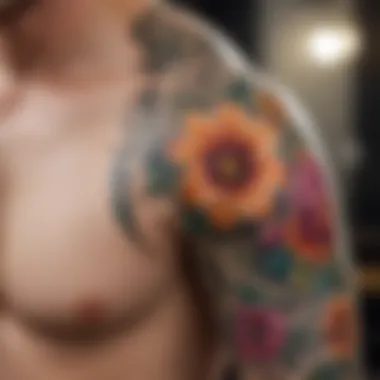
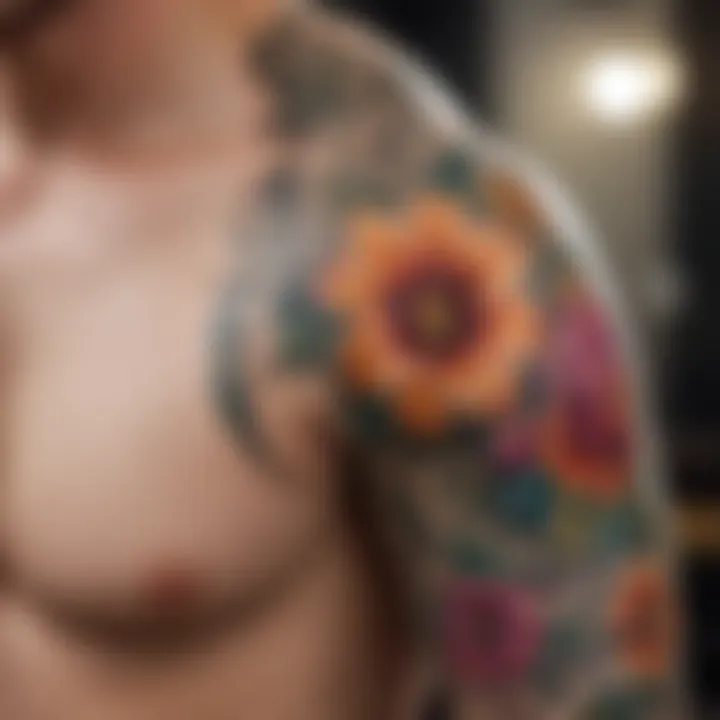
Intro
Arm tattoos represent a notable convergence of personal expression and cultural significance. Their journey traces back to various ancient societies, where they symbolized status, identity, and beliefs. Globally, the significance of arm tattoos varies widely, intertwining with the social and historical context of each culture. While once seen primarily in subcultures, they have gained worldwide acceptance, transforming into commonplace art.
Examining arm tattoos involves more than their aesthetic. They allow individuals to convey personal stories, commemorate significant life events, or simply adorn their bodies with art meant to inspire. The growing popularity of this form of body art warrants a deeper look into aspects such as design choices, best practices for placement, and care methods.
As we delve deeper, this article meticulously unpacks each facet of arm tattoos, informing you on crucial deciding matters behind every tattoo choice. By addressing the trends, styles, and factors influencing the tattoo process, we aim to create a thorough guide for anyone intrigued by the art of arm tattoos.
Historical Origins of Arm Tattoos
Exploring the historical pathway of arm tattoos reveals significant traditions in ancient societies. Cultures, such as the Egyptians and Maori, used body art for various reasons, from rites of passage to tribal affiliation. These tattoos served as symbols of strength and societal standing.
“Tattoos hold our history like a canvas, representing who we are and where we’ve come from.”
Typically, symbols and images held particular meanings, with various cultures interpreting them differently. For instance, in Japan, elaborate designs reflect mastery in art, while in Western societies, tattoos became intertwined with rebellion.
Throughout time, arm tattoos' footprint has expanded. They now reflect personal transformations, conceptual art, or memberships in communities. Words and visuals now adorn skin, creating a personal narrative undeniable to the wearer.
Symbolism and Cultural Significance
Cultural standing is vital in understanding arm tattoos. In some cultures, they denote rites of passage, while in others, they symbolize connection to heritage or identity. Different designs carry different meanings.
Examples of Symbols and Ideas
- Skull Tattoos: Might signify mortality and the cycle of life.
- Heart Tattoos: Commonly represent love and passion.
- Animal Tattoos: Can symbolize traits, such as courage for a lion or wisdom for an owl.
Moreover, understanding the cultural implications of a tattoo can be crucial for accuracy and respect. Appreciating these symbols enhances the reason behind getting an arm tattoo, allowing the wearer to carry their meaning more comfortably.
Contemporary Styles and Techniques
Modern tattooing has evolved significantly owing to advancements in technology and creativity. Artists blend traditional methods with innovative techniques, leading to a variety of styles and expressions.
Popular Styles Today
- Realism: Photorealistic tattoos capturing lifelike detail.
- Watercolor: Using colors in flowing designs, mimicking watercolor paintings, and allowing for unique visual storytelling.
- Geometric: Featuring clean lines and symmetry, presenting a modern twist to body art.
Artists must also navigate proper techniques in achieving clean, well-defined tattoos. Quality equipment and placement procedures ought to be essential factors in a tattoo journey, followed by post-application care for sustainable results.
Considerations for Design and Placement
Choosing the right design and placement is paramount. Arm tattoos offer flexibility, given the arm's varied surfaces, allowing for both small designs and grand artworks. Factors affecting choices include:
- Visibility: Determine if the tattoo should be discreet or showcased prominently.
- Size and Detail: Allow consideration of what intricacies can be achieved in different-sized pieces.
- Longevity: Some styles may age better than others; colors often fade and lines can blur, requiring surgical follow-ups and touch-ups.
Aftercare Essentials
Proper aftercare ensures the tattoo remains fresh, vibrant, and infection-free. Critical aftercare tips include:
- Clean the Area: Gently wash and dry the tattoo to keep the area clean.
- Moisturize: Use tattoo-specific creams or unscented lotions to keep it hydrated.
- Avoid Sun Exposure: Direct sunlight can fade tattoos, using sunblock becomes essential few weeks post-tattooing.
Understanding these aspects can foster appreciation and respect for the tattooing artistry that shapes personal identities today.
Historical Context of Tattoos
Understanding the historical context of tattoos is crucial for appreciating their meaning and evolution. Tattoos have been part of human culture for thousands of years, serving various purposes across different societies. Their significance has varied widely, from rites of passage to social status symbols, and even as marks of beauty or rebellion. This historical backdrop helps in grasping why tattoos, especially arm tattoos, hold weight in contemporary society.
Origins of Tattooing
The origins of tattooing can be traced back to ancient civilizations. Evidence suggests that the practice began over 5,000 years ago. The oldest known mummified remains, found in the Alps—Ötzi the Iceman—feature tattoos that may have served medicinal purposes, as they correlate with acupuncture points. The act of tattooing in ancient cultures, like Polynesian, Egyptian, and Japanese, conveyed deeper cultural meanings.
Historically, many societies used tattoos as part of religious rituals or to signify tribal affiliations. In some cases, tattoos were believed to protect against evil spirits or were left as a testament to bravery in battle. Despite diverse backgrounds, the core essence remains: tattoos often convey identity and serve to mark significant life events.
Cultural Variations
Cultural contexts shape how tattoos are viewed and practiced around the world. For instance, in Japan, tattoos can have a rich tradition tied to artistry and social class, while in America, they often symbolize individuality and freedom. The Maori of New Zealand practice Ta Moko, which is unique in its expression of lineage and social status.
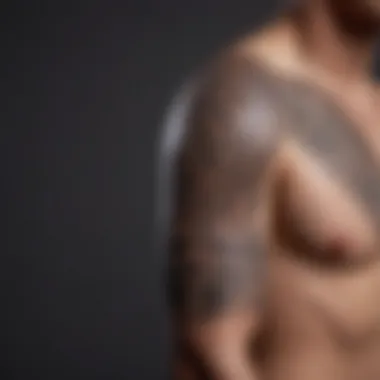
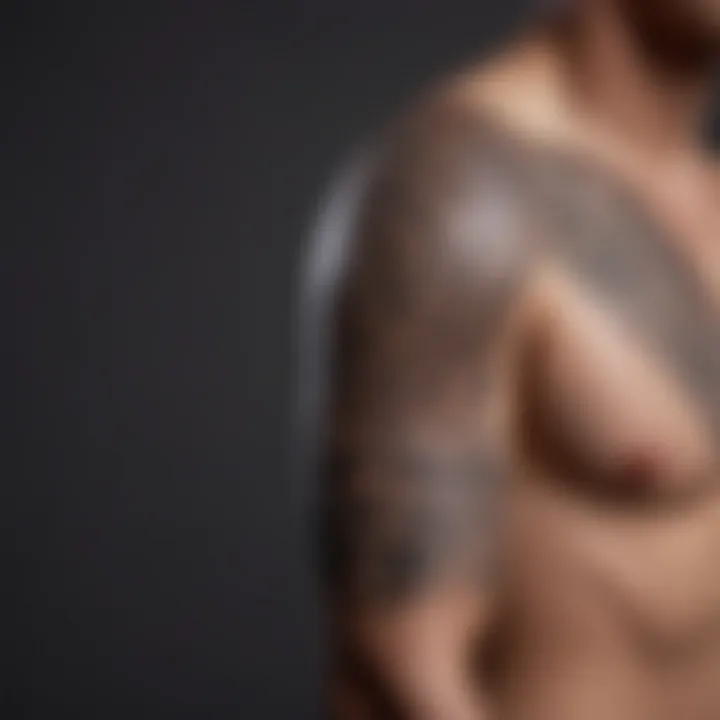
In contrast, tattoos in Western culture have dramatically shifted from associations with criminal elements to a symbol of art and personal expression. Understanding these variations highlights the multifaceted nature of tattoos as they adapt across cultures through time.
Isn't it insightful how art can transform lives and cultures in such meaningful ways? While trends can come and go, the deeper understanding of their significance can add value to one's decision to get tattooed, especially on prominent places like the arm.
Symbolism of Arm Tattoos
Arm tattoos serve as a notable expression of identity and cultural background. They do not just adorn the skin, but convey a deeper significance, embodying personal stories, beliefs, and hidden emotions. Understanding the symbolism behind these tattoos can enhance one’s appreciation for the art form and the choices that individuals make.
Personal Identity
For many people, arm tattoos function as powerful symbols of personal identity. Individuals often choose designs that reflect life experiences, values, or key milestones. For instance, dates, quotes or imagery related to significant events can be inked on the arm. Through these tattoos, wearers declare their unique journey and what matters most to them.
A meaningful tattoo can bolster self-expression. When thoughtfully designed, it narrates stories without uttering a word. This silent eloquence invites curiosity around the personal narrative of the wearer. Moreover, this aspect can influence one’s relationship with oneself—calling forth pride, confidence, and even introspection.
- Choosing the right imagery can make a difference, emphasizing your identity effectively.
- Personal symbols help assert individuality in a world that increasingly celebrates conformity.
Cultural Heritage
Arm tattoos also possess profound ties to cultural heritage. Various cultures ignite symbolic imagery informed by centuries of tradition. This makes each tattoo not only a personal statement but also a messenger of rich history. Individuals may opt for designs symbolizing their roots or connections to their ancestry. This act unfurls stories that are interwoven with the fabric of family narratives.
In many cultures, tattoos had specific meanings tied to rites of passage, achievements, and cultural beliefs. For example, Maori tattoos celebrate tribal identity and personal achievements, using intricate patterns exclusive to family lineage. This sense of belonging through tattoos connects wearers to their heritage, showcasing respect for ancestors and traditions.
“Cultural tattoos act as testaments to identity, merging personal stories with collective history.”
Through understanding the symbolism behind arm tattoos, individuals can appreciate the visually striking artwork on their skin more deeply. Power lies in visibility, telling the world who they are and where they come from simultaneously. Insights gained in exploring the symbolic aspects behind arm tattoos enhance not only the aesthetic value, but also the personal and cultural journeys they represent.
Popular Styles of Arm Tattoos
Understanding the various styles of arm tattoos is essential for anyone considering this form of self-expression. Each style carries its history, aesthetics, and meanings. The choice of a tattoo style often reflects personal identity, cultural affiliations, or aesthetic preferences. Selecting a style can significantly enhance the impact an arm tattoo makes, both visually and emotionally. When choosing a tattoo, individuals should consider how the style aligns with their narrative or artistic vision.
Traditional Designs
Traditional tattoos are a cornerstone of the tattoo culture, originating from seafarers and cultures that sought to represent their identities through body art. These tattoos often feature iconic symbols and bold lines, characterized by vibrant colors. Common elements include anchors, roses, and sparrows. Their enduring appeal is rooted in how they capture timeless emotions and themes related to love, strength, and adventure. The designs are straightforward, making them an interesting option for individuals who value classic aesthetics and cultural symbols.
Abstract and Geometric
Abstract tattoos challenge conventional perceptions of form and meaning. They blend shapes, lines, and negative space to create striking visuals that may not have literal representations. This style appeals to those who prefer a more modern interpretation of tattoos, emphasizing unique designs that often invite personal interpretation.
Geometric tattoos use lines, shapes, and patterns to create harmonious visuals, often inspired by mathematics. The repetitiveness and symmetry associated with geometric art brings a sense of calm and order.
Choosing abstract or geometric designs requires introspection into one's idea of aesthetics and individuality, enabling one to showcase a personal philosophy or a journey through art on their skin.
Realism and Portraits
Realism in tattooing demands exceptional skill from the artist. This style aims to replicate photographs or images with utmost detail, whether depicting people or natural scenes. Portrait tattoos have gained popularity due to their ability to immortalize connections, from loved ones to inspirational figures. A realistic arm tattoo can uniquely communicate deep personal stories and relationships. Choosing realistic styles means selecting proficient tattooists specializing in lifelike renderings, as the success of this type hinges heavily on the choice of artist.
Blackwork and Tribal
Blackwork tattoos often utilize black ink prominently, creating striking and bold images that stand out. These designs can range from intricate patterns to large solid pieces that cover significant areas of the skin. Tribal tattoos draw from ancient cultures, evoking a sense of connection to heritage and timeless rituals. Typically featuring intricate lines and curved shapes, tribal pieces symbolize great personal and communal significance.
For those considering an arm tattoo, blackwork or tribal elements speak to both aesthetic grit and connections to cultural histories. Mastering such designs may also express solidarity and lines of identity.
Ultimately, the style selected should resonate with the wearer, embodying their essence and values.
Exploring various styles allows individuals to appreciate the nuances of tattoo art and their potential personal significance.
Design Considerations
The process of getting an arm tattoo is intricate and involves many factors that can significantly affect the outcome. One of the most pivotal aspects is the design. A well-conceived tattoo reflects not only artistic elements but also personal significance. When considering a tattoo, an individual should project how the imagery aligns with personal beliefs and values. This alignment enhances the sentimental value of the tattoo, marking the body with a lasting impression of personal triumphs or identities.
Meaningful Imagery
Creating meaningful imagery transforms a mere aesthetic into a personal narrative. Before getting a tattoo, it's crucial to ponder what images or symbols resonate deeply. For instance, some choose cultural symbols that connect them to their roots, while others might select personal icons like animals, which depict qualities they cherish. Such tattoos serve as visual reminders of values and life events. An image that captures a moment or emotion can evolve into a powerful part of self-identity.
It’s beneficial to sketch these designs or find artists skilled in rendering specific imagery. Collaborative brainstorming enhances involvement in the art-making process, creating a shared vision between tattoo artist and client. It's imperative the resulting design withstands time and aging; detailed illustrations or abstract shapes with clear contours tend to fare better over the years.
Color vs.
Black and Gray
When choosing between color and black and gray, several components come into play. Each approach communicates different aesthetics and emotional tones. Color tattoos often evoke vibrancy and energy. They can capture multifaceted aspects of the intended symbolism. Though they may be spectacular, color tattoos require more aftercare to maintain their vibrancy as the years pass.
In contrast, black and gray tattoos emphasize shadow and texture. Their subtleness can translate to timelessness, offering a classic appeal. They tend to age better without losing aesthetics. This realization often prompts many to experiment with blending the two. Designers can draft styles incorporating elements of both, yielding striking contrasts that are visually engaging.


Balancing color with gray creates multidimensional effects attracting attention and admiration.
Ultimately, the decision should be guided by personal taste, practical considerations regarding aftercare, and long-term visions for the tattoo. Remember, whether color or black and gray, the tattoo will leave an indelible mark on the skin and your life, prsenting various narratives for years to come.
Placement of Arm Tattoos
Placement of arm tattoos is a critical aspect to consider when planning for body art. The location impacts not only the visibility of the artwork but also its personal meaning and the way it aligns with one’s lifestyle. Each placement comes with unique advantages and potential drawbacks. Therefore, understanding the implications helps individuals make well-informed decisions regarding their tattoos.
Full Sleeves
Full-sleeve tattoos cover the entire arm from the shoulder to the wrist. This placement allows for a larger canvas and the opportunity to showcase complex designs. It becomes a visual narrative that transforms the limb into a piece of art that tells individual stories. However, full sleeves require a significant time commitment and financial investment. Users must also consider the social acceptance of their choices, as these tattoos are highly visible.
Key considerations for full sleeves include:
- Commitment: Requires multiple sessions over an extended period.
- Expertise: Finding a skilled artist can significantly impact the results.
- Professional Impact: Highly visible tattoos may influence professional opportunities in certain industries.
Half Sleeves
Half-sleeve tattoos offer a more moderate approach, covering either the upper or lower half of the arm. They provide the artistic flexibility of full sleeves without the full commitment. This placement can be just as impactful. Options in design and theme are abundant, allowing for a mix of aesthetics.
Main points for half sleeves:
- Visibility: Easier to cover than full sleeves in professional settings.
- Designs: Easy access for touch-ups or modifications, allowing for personalization.
- Maturity: They are often viewed as a less intense expression of body art, making them appealing to those exploring arm tattoos.
Small Tattoos
Small tattoos offer a more subtle form of expression, often strategically placed on the arm, such as the wrist, forearm or shoulder. This placement not only emphasizes precision in design but also allows for meaningful symbols or words. Small tattoos can carry rich personal significance despite their size.
Advantages of small tattoos:
- Flexibility: Easy to conceal or display based on social circumstances.
- Simplicity and focus: Automatic draw to the intricacies of smaller designs.
- Cost-Effective: Generally requires less time and financial investment compared to larger tattoos.
Choosing the right placement for an arm tattoo is essential. It defines not only the visibility but also elicits feelings and reflects personal expressions unique to the individual.
Thoughtful consideration should be given to full sleeves, half sleeves, and small tattoos, each type presenting distinct attributes that cater to individual preferences and needs.
Tattoo Application Techniques
Tattoo application techniques play a pivotal role in creating a successful piece of body art. These methods directly impact the outcome, taking into consideration the intricacy of designs and the comfort of the individual receiving the tattoo. Becoming aware of these techniques can directly influence an individual's decision, as well as enhance the experience during the tattooing process.
The Tattoo Machine
The tattoo machine, often referred to as a tattoo gun, is the predominant tool used for modern tattooing. Its functionality incorporates electromagnetic coils that drive the needles up and down. This movement punctures the skin, depositing ink into the dermal layer.
The precision of the machine allows artists to achieve varying depths and speeds according to the chosen style of tattoo, whether it be intricate line work or shading. One notable advantage of the tattoo machine is the capability for repeatability and predictability. Consequently, this results in designs that are more consistent than traditional methods.
However, the cost and complexity of the device necessitate thorough training. Artists must understand how to calibrate their machines to prevent issues such as over-insertion, which can lead to blurred designs or excessive pain for the client.
Hand-Poked Tattoos
Hand-poked tattoos engage a more primitive technique, employing a single needle and ink of the artist's choice. Unlike machines, this method involves manual efforts where the tattoo artist skillfully places each dot into the skin.
This technique resonates with clients seeking simplicity or an artisan touch. There’s a sense of authenticity associated with hand-poked tattoos that some artists and clients find appealing. The control and pace it affords means that the experience often feels less rushed and may appear more aligned with one’s individual artistic sensibilities.
Nonetheless, a hand-poked tattoo can necessitate more time to complete, as artists must master the technique to ensure clean, effective application. Moreover, the healing process can differ due to the technique’s nature, potentially leading to varied ink saturation levels compared to machine tattoos.
"Tattoo techniques are not just about results; they are about experience. The method should align with personal expectations and the narrative one wants to convey through their body art."
Aftercare and Maintenance
Proper aftercare and maintenance of arm tattoos is crucial for both aesthetic and health reasons. Taking the right steps to care for a new tattoo can significantly affect its appearance over time. Neglecting to follow proper procedures can lead to fading, infections, and other complications that diminish the tattoo's quality.
Immediate Aftercare
The first hours after getting a tattoo are vital. Keeping the tattoo clean will help at this moment.
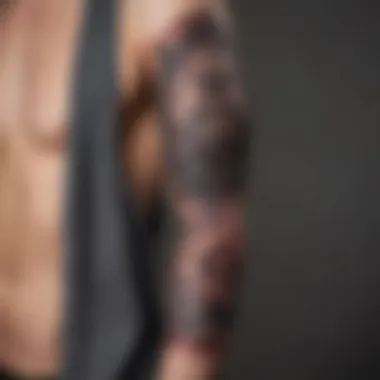
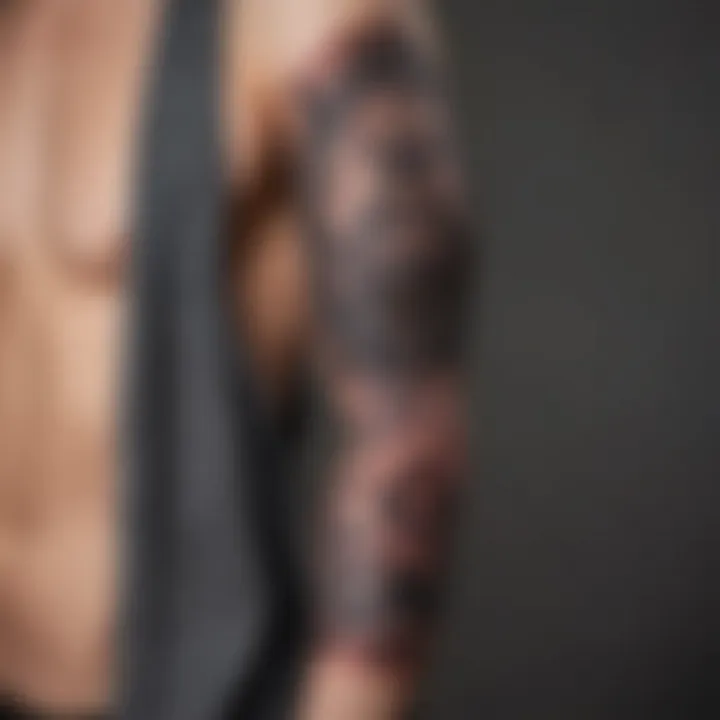
- Wash Hands: Always wash your hands thoroughly before touching the tattoo to minimize the risk of infection.
- Removal of Bandage: Follow the artist's advice on when to remove the initial bandage. It is ordinarily advised to keep it on for several hours, sometimes overnight.
- Gentle Washing: Once the bandage is removed, gently wash the area with lukewarm water and mild, fragrance-free soap. Pat the area dry with a clean towel, not wwwiping, to avoid irritating the fresh ink.
- Moisturizing: Apply a thin layer of tattoo aftercare ointment. Follow the tattoo artist's instructions on which product to use, as this can vary.
- Avoid Water Exposure: In the first few weeks, avoid soaking in pools or baths. Showering is ok as long as water does not directly hit the tattoo.
Effective immediate aftercare helps in reducing skin irritation and infection risk.
Following proper aftercare guidelines at this stage ensures the longevity and vibrancy of the tatto.
Long-Term Care
As time passes, continuing with solid long-term care is equally important. A tattoo ages and needs consistent care to retain its quality.
- Sun Protection: UV rays can significantly affect the fading of ink. Use sunscreen with high SPF when exposed to sunlight. It is wise to look for specific products designed for protecting tattoos.
- Moisturization: Regularly moisturize the tattooed area to keep the skin hydrated and prevent dryness and flakiness.
- Watch for Changes: Be mindful of any changes in the tattoo or surrounding skin. Unusual redness, swelling, or discharge could indicate an infection, requiring medical attention.
- Regular Skin Care: Maintain a routine that includes gentle exfoliation around the tattoo to remove dead skin, but avoid harsh products on the tattoo itself.
- Consult Professionals: For serious concerns, seek advice from your tattoo artist or a medical professional. A small issue can evolve into a larger problem if not addressed early.
Long-term care can vastly improve the tattoo's lifespan and ensure that it stays as sharp and vivid years later as the day it was inked.
Common Misconceptions
The topic of arm tattoos often comes with numerous misconceptions that can mislead both prospective and current tattoo enthusiasts. Understanding these misconceptions is vital as it can help individuals make informed decisions about body art. Misunderstandings related to tattoos can arise from cultural biases, societal perceptions, and prevailing myths that have developed over time.
Tattoos and Professionalism
One prevalent misconception is the belief that having tattoos negatively affects a person's professionalism. Many fear that visible tattoos will lead to discrimination in the workplace. However, this perspective needs further examination. In recent years, many industries have embraced tattooed individuals. Companies seek diversity and inclusion, which often includes personal expression through tattoos.
It is essential to recognize that professionalism varies by industry. While some fields like finance or law may have more traditional views about tattoos, creative industries, technology, and even customer-facing roles have become more accepting. Hence, the idea that tattoos always harm prospects is overly simplistic. Tattoos can, in fact, reflect individuality and confidence—traits often regarded positively.
Pain Levels and Experiences
Another common misconception relates to the pain associated with tattooing. Many believe getting a tattoo is agonizing, proportional to how intense the needle's sound may seem. In reality, perceptions of pain vary widely among individuals. Factors like personal pain tolerance, location on the body, and the size of the tattoo play significant roles in how one experiences pain during application.
Some areas, like the forearm or biceps, typically experience lower pain levels when compared to regions with thinner skin or near bones. Additionally, modern tattoo machines and techniques have evolved considerably.
Trends in Arm Tattoos
The landscape of arm tattoos has evolved significantly over the years, influenced by social shifts and cultural exchanges. Recognizing these trends gives deeper insights into the ways people signal their identities or connect with various communities. This section delves into the palpable impact that social media has had on tattoo culture, and how customization and personalization have dramatically infused individuality into tattoo choices.
Influence of Social Media
Social media is reshaping how people perceive tattoos and their significance. Platforms like Instagram or Pinterest ignite creativity and foster trends where users seek inspiration for their next inked artwork. This is where the divide begins — tattoos that may have seemed obscure or clichéd gain validation through likes and thematic feeds.
- Visibility: More artists and enthusiasts can showcase vivid portfolios. In this competitive space, increased visibility leads to curious exploration of different tattoo styles.
- Networking: Artists today connect directly with clients, ensuring personalized designs match the individual's style.
- Mini-Trends: Novel trends, often initiated by influential personalities, trigger a wave resulting in similar requests.
As a result, arm tattoos may vary dramatically in character from one season to the next under cultural and aesthetic influences across platforms:
“Social media acts as both a mirror and a lamp, reflecting existing styles and illuminating new ones.”
Customization and Personalization
The desire for unique expression in the body art spectrum results in customization plans that resonate with personal stories, cultural relevance, and aesthetic preferences. Being able to tailor a tattoo offers individuals a sense of ownership over their ink that broad designs cannot.
- Artist-Client Collaboration: Conversations between artists and clients improve creations through shared experiences and tailored designs.
- Meaningful Symbols: Individuals are opting for images or words that are significant to them personally, transcending the ordinary to evoke memories or aspirations.
- Segmented Demographics: Varied age groups engage differently — from whimsical youngsters to mature individuals with reflective backstories.
This ongoing need for personalization ultimately creates a tapestry of arm tattoos that reflects a wide array of identities, narrating diverse and inclusive personal journeys beyond societal norms. As fashion trends evolve, so does the appetite for tattoo styles suited precisely to individual needs and self-expression.
The Future of Arm Tattoos
The significance of arm tattoos continues to evolve. As society becomes more accepting of body art, the future holds numerous possibilities for creativity, technique, and appreciation for this form of expression. This section focuses on important elements affecting arm tattoos, such as technological advancements and changing cultural perceptions.
Technological Advancements
Advancements in technology dramatically change the way tattoos are created and perceived. Tattoo machines are now more precise, minimizing pain and enhancing the final look of tattoos. Innovations include the use of rotary machines that create smoother lines. Additionally, new inks offer richer colors and better durability.
The introduction of digital design software allows artists to create and visualize complex designs before application. This leads to fewer mistakes and results in enhanced personalization for clients. Moreover, some tattoo studios are utilizing 3D printing technology, opening doors to unique, multi-dimensional tattoos not seen before. This inevitably shifts the way clients approach getting arm tattoos. They are becoming less about traditional designs and more about custom pieces that reflect personal stories.
Evolving Cultural Perceptions
Cultural views of tattoos have transitioned significantly over recent years. Historically, body art might have been viewed negatively, often linked with rebellious behavior or simple aesthetics. Now, arm tattoos symbolize practicality and self-expression. An increasing number of mainstream celebrities showcase elaborate arm tattoos, normalizing their presence across various demographics.
Moreover, there has been a rise in tattoo conventions which celebrates all styles of tattoos. These events encourage dialogue around costs, care, and risks while providing a platform for artists to showcase their works.
As perceptions evolve, more professionals are comfortable displaying tattoos as part of their identity and work attire. Such trends may also lead to companies reassessing hiring policies to be more inclusive of body art.
"The relationship between tattoo art and societal acceptance is complex, continually changing as the world becomes more interconnected and diversified."
In summary, the future of arm tattoos is reshaped by increased innovation and a shift toward a more accepting culture. By understanding these shifts, individuals can make informed choices reflecting their identity, valuing how technology allows unique artistic expressions.















